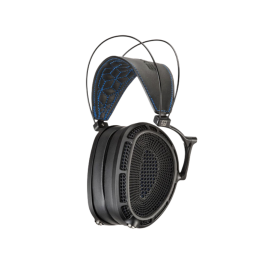Here's what I mean. Is it yet possible to mic a room and when the volume of the mic mixer is no louder than your surroundings, not be able to tell you're listening through headphones because of the design of the headphones?
Yes, this is possible, but as restorer-john said, if you want to actually do this, it depends a lot more on how the recording is made, than the headphones. It's actually easier to do with IEMs than over-ear.
The whole problem with creating this type of illusion has to do with the shape of your ears. Everything you hear is filtered by your head, shoulders, and ears especially. Your brain uses this filtering to figure out where things are (spatial cues).
Speakers can create spatial cues because the sound still hits your body and ears like anything else.
Headphones really struggle with spatial cues, because suddenly your shoulders, head, and parts of your ears are removed from the equation. By putting the sound source so close to your ear, you bypass a lot of this natural filtering. It's as if your brain is expecting some EQ but you've shut off 2/3 of it. This is why the harman headphone curve is not nearly flat. We have to add back some of that natural "EQ".
However, the process of "adding back" the filtering from our ears and heads etc. is a very imperfect science, unless you have detailed scans of your ears and a very good spatial audio software.
One way to get around this - make the recording in the room using a binaural mic setup with little models of your ears in front of the microphones. Then you listen on IEMs and it will sound perfectly real, as you describe. Another way - get an HRTF filter of your own head and ears, and apply it to a binaural recording made without fake ears attached. Last way - make a binaural recording yourself, with the mics IN your ears. (yes, people do this.) It will sound basically real when you listen on IEMs.
To achieve this with over-ear headphones, you're up against a tricky problem, because the sound wave will never hit your ear quite right, to totally fool your brain. This is why auditioning headphones is really important if you want a true illusion. The radiation pattern of sound inside the cup varies (some are angled, there may be lobing in there, who knows), and its interaction with your own ear cannot be predicted.
So in terms of raw performance most cans in this thread are good enough to do what you're talking about. HOWEVER, none of them are
likely to create a true 3D illusion for you in the way you describe.
If you are literal and serious about your goal, my advice is to get a binaural recording or three (raw, with your ears, with jig), take the recordings to AXPONA or similar, and demo as many headphones as you can. You may get lucky and find the magic set for your ears.
If you just want headphones that are good enough to create perfect realism
in theory then I think there are good recommendations here already. I would suggest finding some with really low distortion so you have a lot of flexibility to EQ.



